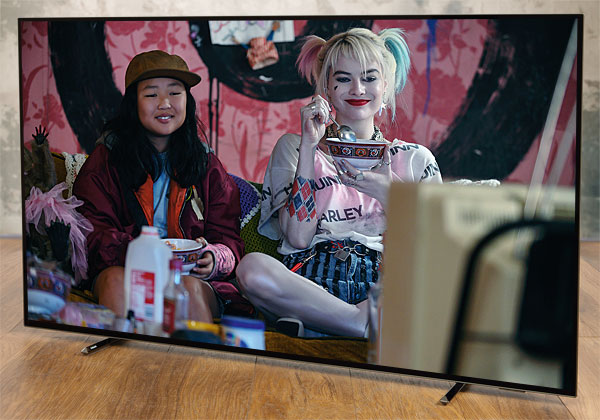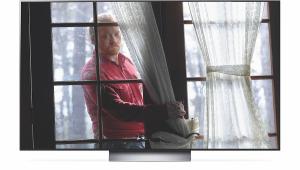Philips 55OLED805 4K OLED TV Page 2
The OLED805 offers universal HDR support, with both Dolby Vision and HDR10+ catered for, alongside regular HDR10 and HLG, and its performance is impressive, with its handling of small, pinpoint highlights particularly dramatic. I measured a peak brightness of 900 nits with a 5 per cent HDR window using the Vivid setting (with light sensor and related energy-saving gubbins switched off). Flitting across to Standard mode saw these peaks drop to a still mighty 850 nits.
 Filmmaker Mode, from the UHD Alliance, is supported too (Dolby Vision IQ isn't), although I suspect Philips would have you leave its own picture processing in play, rather than turn it off. Unlike on Panasonic's TVs [see our TX-58HX800 review, HCC #313], Philips doesn't offer access to Filmmaker Mode via a dedicated button on the remote handset. Instead, it can be triggered by an FMM metadata flag in content. As yet there's nothing in the wild with such a metadata flag, so Philips directs users to the Movie mode instead, although that clearly has some elements of image processing active, so it's not really the same thing.
Filmmaker Mode, from the UHD Alliance, is supported too (Dolby Vision IQ isn't), although I suspect Philips would have you leave its own picture processing in play, rather than turn it off. Unlike on Panasonic's TVs [see our TX-58HX800 review, HCC #313], Philips doesn't offer access to Filmmaker Mode via a dedicated button on the remote handset. Instead, it can be triggered by an FMM metadata flag in content. As yet there's nothing in the wild with such a metadata flag, so Philips directs users to the Movie mode instead, although that clearly has some elements of image processing active, so it's not really the same thing.
The screen's near-black detail is knockout. Shadowed Andalusian catacombs seen in Warrior Nun (Netflix 4K) retain detail in their stonework, while full blacks are dense and solid. Candles flicker in the darkness with HDR intent unaffected.
When Leia is blasted into space during the First Order ambush (Star Wars: The Last Jedi, 4K Blu-ray), her face slowly crystallising with ice, the image has almost three- dimensional depth. Colour vibrancy is similarly mouth-watering. Chewie's spit-roasted Porg had me salivating...
Motion Slickness
Philips appears to have calmed the slightly over-aggressive colour vibrancy witnessed on last year's OLED804, and this helps prevent the Vivid mode, in particular, from looking over oversaturated. The TV's colour handling still enjoys characteristic pop, though. Greens are lush, if not quite as strong as those on its predecessor.
The brand has also made some significant tweaks to motion processing, introducing an all new Pure Cinema mode that proves to be sensationally good. It retains cinematic judder but upscales 24p original footage to 120Hz, and the result is an immersive cinematic representation, without soap opera distractions, yet retaining crisp detail. It's the motion interpolation technology film fans have been waiting for.
There are so many picture options on the OLED805 that working through the various combinations can be baffling. Many buyers simply won't bother exploring. For everyday content, I'd suggest leaving the set on its AI setting. When it comes to cinema, I thought the Natural preset, with Pure Cinema Motion selected, was the ideal compromise for films and blockbuster telly.
Sports fans might feel miffed that there's no dedicated Sports image preset now. It's been replaced by a Movie mode that executes a low level of de-judder and de-blur. As there's no visible artefacts, or soap opera effect, this setting works for a variety of content.
If the OLED805 has an achilles heel it's gaming performance. I measured input lag at 33.2ms (1080p/60) using the dedicated Game mode. There are better-performing gaming OLEDs out there.

Audio delivery is more on the money. A revamped speaker design (including larger mid-range and high-frequency drivers, and additional passive radiators for deeper bass) makes this a step up from the OLED804. It boasts an impressive 50W of amplification. Even taking marketing ebullience onboard, it's a strident performer.
Dolby Atmos support is standard, although you'll want to bitstream it out over ARC to a compatible soundbar or home cinema system to make the most of it.
Ambitious Specification
Overall, the 55in OLED805 is a cracking display, one that combines outstanding image quality with an ambitious specification and interiors-friendly Ambilight. Improvements to picture processing through AI and Philips' all-new motion handling engine warrant two thumbs up.
There are caveats, of course. If next-generation gaming is a pending obsession, then LG's CX Series (its new entry-level range, including a 48in model) could well be the better buy, while Panasonic looks set to monopolise the cinephile market with its high-end HZ2000 TV. But if you're after a screen that pushes the image envelope, has style chops and a superior level of smart functionality, it's a brilliant buy at an eye-catching price n
HCC Verdict
Philips 55OLED805
Price: £1,500
www.philips.co.uk
We say: Philips' P5 picture processor with AI is a step forward in picture quality, but that's only part of this well-priced OLED's feature-rich kerb appeal.
Overall: 5/5
Specification
4K: Yes. 3,840 x 2,160
HDR: Yes. Dolby Vision; HDR10+; HLG;
HDR10 Tuner: Yes. Freeview HD (Freeview Play); satellite HD
Connections: 4 x HDMI inputs; component AV; digital optical audio output; 2 x USB; Ethernet; headphone out
Sound (CLAIMED): 50W (2 x 10W + 30W subwoofer)
Brightness (CLAIMED): N/A
Contrast ratio (CLAIMED): N/A
Dimensions (off stand): 1,227.8(w) x 705.6(h) x 58(d)mm
Weight (off stand): 21.8kg
Features: Three-sided Ambilight; dual-band Wi-Fi; Bluetooth 4.2; P5 Picture Engine with AI; Perfect Natural Motion: Android TV (v9); Chromecast built-in; Google Assistant built in; Works with Alexa; Dolby Atmos
 |
Home Cinema Choice #351 is on sale now, featuring: Samsung S95D flagship OLED TV; Ascendo loudspeakers; Pioneer VSA-LX805 AV receiver; UST projector roundup; 2024’s summer movies; Conan 4K; and more
|

















































